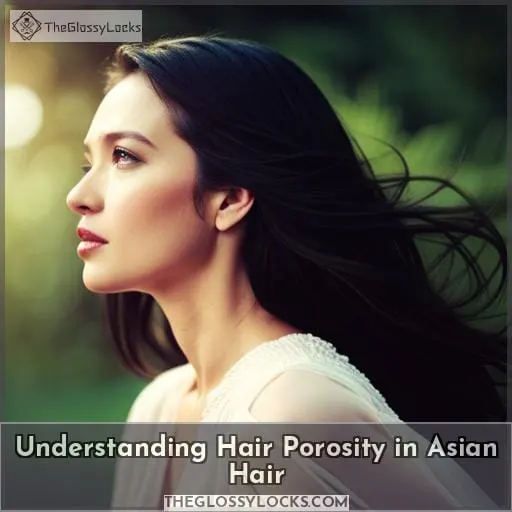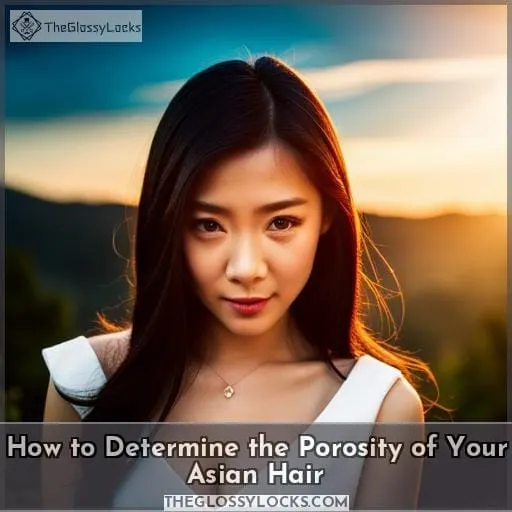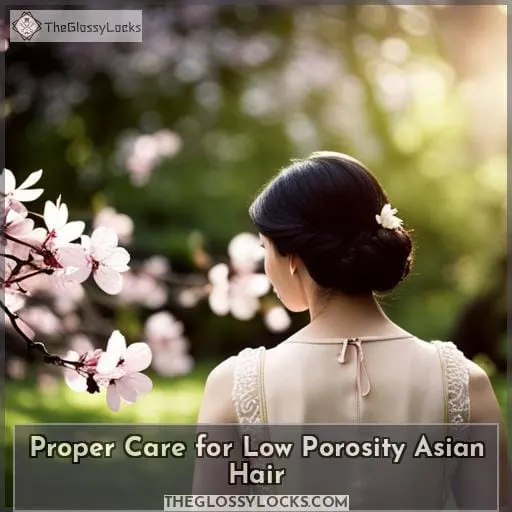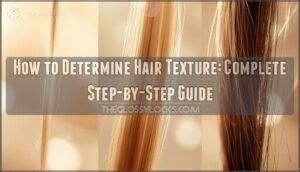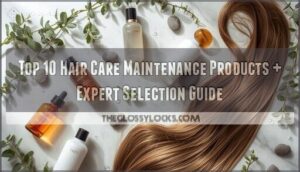This site is supported by our readers. We may earn a commission, at no cost to you, if you purchase through links.
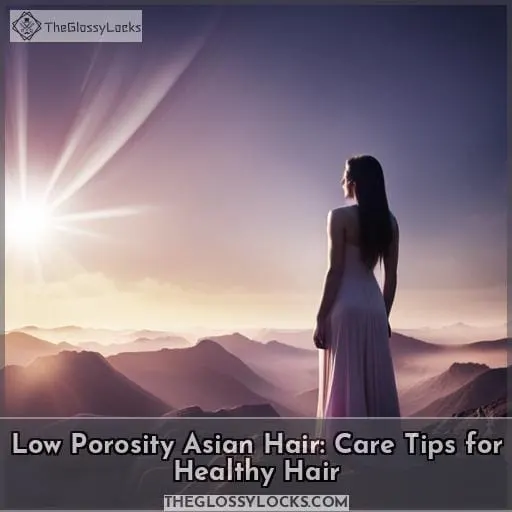
We will discuss how to determine whether your Asian hair is high, medium, or low in terms of its porosity. Additionally, we will provide effective strategies for each type so that you can take better care of your tresses.
With our easy-to-follow tips and tricks, get ready to discover a whole new world when it comes to keeping up with the maintenance of all types of beautiful Asian locks!
Table Of Contents
Key Takeaways
- Low porosity Asian hair is resistant to moisture and difficult to penetrate with products.
- Clarifying shampoo can be used to remove buildup and open the cuticles for better product absorption.
- Heat can be used to open the hair cuticles and allow for better product absorption.
- Humectants like glycerin can be used to retain moisture in low porosity Asian hair.
Understanding Hair Porosity in Asian Hair
Asian hair porosity varies from low to high, with each type requiring different care. Low porosity Asian hair is resistant to moisture and chemicals, while medium porosity Asian hair requires less maintenance but still benefits from occasional deep conditioning with protein treatments.
High porosity in Asian hair often results in gaps within the cuticles that lead to excessive frizziness; it needs special attention such as using leave-in conditioners and sealants for optimal hydration.
High Porosity in Asian Hair
You can identify high porosity in Asian hair by its tendency to frizz and absorb moisture quickly, whereas low porosity locks out humidity and resists chemical treatments. Causes of high porosity include genetics, heat styling, over-processing with chemicals, or untreated water damage.
Managing frizz requires anti-humectants like silicones for humid climates, while repairing damage needs protein treatments such as deep conditioning masks and leave-in conditioners. The best products for Asian hair are lightweight oils, butters, or sealants that help prevent moisture loss without weighing down the strands too much.
Regular trims will also help keep split ends at bay so your style looks fresh always!
Medium Porosity in Asian Hair
Discovering your hair’s medium porosity can open up a world of styling possibilities, allowing you to enjoy the best of both low and high porosity benefits. With medium porosity, perming techniques retain longer-lasting curls, and color treatments are less likely to fade quickly.
Haircuts stay in shape for longer periods, while protective styles like braids allow versatility with minimal maintenance.
To keep hair healthy long-term, opt for natural products that won’t weigh down strands or strip away moisture; lighter oils work best! Deep condition regularly so cuticles remain supple without having to use heavy creams or waxes.
Protein treatments should be used sparingly as they may affect texture over time.
If you want beautiful locks but don’t have much time on your hands, medium porosity is just right for you!
Low Porosity in Asian Hair
Unlock the secrets of your strands with low porosity Asian hair, like a hidden garden waiting to bloom. Humidity and heat can be particularly damaging for this type of hair, so styling techniques should minimize heat exposure and use special anti-humectants.
Use lighter oils or products without silicones or sulfates; deeper conditioners help open cuticles while avoiding protein treatments. Clarifying shampoos work well to remove buildup from the scalp and strands alike.
How to Determine the Porosity of Your Asian Hair
Determining the porosity of your Asian hair can be done through two different tests: the Float Test and Texture Test. The Float Test involves filling a glass with water, dropping strands of hair into it, and observing which ones float or sink to determine their porosity level.
With the Texture Test, you run your fingers along a strand of freshly washed hair to feel for smoothness or roughness as an indicator of moisture absorption capabilities.
Conducting the Float Test
To determine your hair’s porosity, try the float test! Fill a bowl with water and drop in a single strand of clean, dry hair. Observe how quickly it sinks or floats to the surface: if it sinks fast, you have low porosity; if it floats for a long time or floats slowly, you have high porosity.
Avoid common mistakes like using oily strands and not waiting for them to dry completely before testing. Alternatives to the float test include the texture test and strand tests. These tests are easier but less accurate than the float test.
Interpreting the results of the float test is key. If your hair sinks fast, it indicates low porosity and resistance to moisture. If your hair floats for a long time or floats slowly, it indicates high porosity and gaps or frizz, which may indicate damage.
In this case, deep conditioning, scalp treatments, and an appropriate haircare routine with products like clarifying shampoo are needed.
The float test is more accurate but takes longer, while the texture test allows you to feel the curl pattern instantly without waiting for drying time. So choose wisely between the two tests based on your preference and time availability.
Performing the Texture Test
Feel the texture of your hair with your fingertips to determine if you have low porosity Asian hair. Porosity indicators include smoothness, dryness, and quick absorption of water or product.
When performing a Texture Test on Asian Hair, run your fingers through strands to feel for resistance and a slick feeling. This will help identify proper techniques for your hair type. For example, if you have low porosity locks, you may need to use a clarifying shampoo to remove build-up.
Additionally, using lighter oils and products can help prevent moisture loss, as low porosity hair is more prone to frizziness and damage from heat styling tools.
It’s important to address any misconceptions about suitable products for your hair type with an experienced stylist. This will help prevent damaging mistakes caused by incorrect knowledge about your individual hair type.
Proper Care for Low Porosity Asian Hair
Taking proper care of your low porosity Asian hair is essential for achieving healthy, beautiful locks. Clarifying shampoos can help remove product buildup, while utilizing heat during deep conditioning helps open up the cuticles and absorb moisture.
Protein treatments should be avoided to prevent further resistance to moisture absorption, but humectants like glycerin can provide hydration in dry climates if used with caution.
Clarifying Shampoo for Build-Up Removal
For low porosity Asian hair, clarifying shampoo can be an effective solution to remove build-up and restore vibrancy. Different types of clarifying shampoos are available, depending on your scalp type and the ingredients in the products you use.
Benefits include removing product buildup from styling products or hard water minerals without stripping away natural oils or drying out strands. Regular shampoo won’t have this effect as it’s designed for cleaning rather than providing a deeper cleanse that removes excess build-up from hair follicles.
Clarifying shampoos made specifically for oily scalps will contain gentle surfactants that combat oiliness while preserving moisture balance, while those formulated with chelating agents help dissolve hard water deposits on hair shafts quickly and efficiently.
Utilizing Heat for Moisture Absorption
With heat helping to open the cuticles, allowing moisture into your hair’s tight surface, you can get a real glimpse of its potential for softness and shine. Utilizing heat safely is key when caring for low porosity Asian hair. Heat styling techniques, such as blow drying or using curling irons at cooler settings, are perfect for getting desired results without compromising on health.
Invest in good quality heat tools that have adjustable temperature controls and use them with leave-in products like thermal protector sprays to prevent damage from occurring due to high temperatures.
Treat yourself by indulging in regular deep conditioning treatments, which will help nourish your tresses while also providing extra hydration – this should be part of any haircare routine! The right balance between adequate moisturization, coupled with sensible usage of heated tools, ensures healthy-looking locks all year round.
Avoiding Protein Treatments
Avoid protein treatments for your locks, as they can make it more resistant to moisture absorption. Instead, opt for lighter oils and products designed specifically for low porosity hair. A conditioning treatment with heat will open up the cuticles to retain moisture better than just using a product alone.
Additionally, avoid humectants like glycerin in humid climates since they could lead to further frizzing of already dry strands. Clarifying shampoo is also beneficial as it helps remove buildup on the scalp and hair shafts without stripping away natural oils or creating additional damage from harsh chemicals.
For best results, consider investing in quality products that are free from silicones, sulfates, parabens, and phthalates, which can cause further harm if used too often with Asian low porosity hair type.
Using Humectants for Hydration
To hydrate your low porosity Asian hair, try using humectants like glycerin that draw moisture from the air. Humectants can balance out emollients and lock in moisture for a healthier look.
Be mindful when selecting a product as some may be too strong or not suitable for humid climates. Glycerin is generally considered one of the best humectant options available and helps with dryness without causing any damage to strands.
When used properly, it can help make your hair more manageable while promoting shine and softness.
However, if you have high porosity hair, avoid using products containing humectants since they could further increase frizziness instead of providing hydration!
Effective Hair Care Strategies for Medium Porosity Asian Hair
Taking care of Asian hair with medium porosity is a manageable task. To maintain its healthy condition and shine, it’s important to include occasional deep conditioning treatments, balanced protein treatments, and minimal heat styling in your regular hair care routine.
Incorporating Occasional Deep Conditioning
Occasionally treating your hair to a deep conditioning session will help keep it looking and feeling its best. Deep conditioners are specially formulated for Asian low porosity hair, restoring essential moisture while preventing further damage from heat styling or chemical treatments.
For optimal results, use the right product according to your scalp type. Oily scalps benefit from lightweight serums, while dry scalps need heavier creams and oils.
The frequency of deep conditioning should be determined by texture. Thick strands should be deep conditioned once a month, thin locks twice a month, and damaged or brittle hair should be deep conditioned weekly.
Experiment with different types of deep conditioners as well as techniques such as steam treatments and hot oil massages.
With proper care tailored specifically towards medium porosity Asian Hair, you can enjoy thicker locks that look shiny in no time!
Balancing Protein Treatments
For medium porosity Asian hair, it’s important to strike a harmonious balance between protein treatments and deep conditioning for optimal hydration and shine.
To replenish moisture levels without overloading the cuticles with proteins that could leave your hair feeling dry or brittle, use a protein-free conditioner.
If you have damaged strands, consider using Calia Natural’s Ultra Moisturizing Deep Conditioning Masque occasionally. This product is designed to repair and nourish your hair, leaving it feeling soft and healthy.
Another option is to apply coconut oil before shampooing. This will help protect your hair against damage while also strengthening its structure from within.
After styling, it’s a good idea to apply an oil-based product. This will help distribute sebum more evenly throughout your hair, which can help combat frizz and leave you with shinier locks.
Minimizing Heat Styling
Minimize heat styling to protect your hair from further damage and keep it looking healthy. Air-drying is a great option for medium porosity Asian hair. The natural drying process doesn’t apply direct heat that can cause breakage.
If using a blow dryer, opt for one with an adjustable temperature setting so you don’t overdo it.
Before applying any form of heat styling tool to your locks, use a scalp serum or oil product as protection against damage and frizzing caused by the hot air/heat produced by these devices. For extra protection, consider protective hairstyles like braids or buns. They will reduce friction between strands when combing or brushing wet hair after washing.
Finally, always have some microfiber towels handy. They’ll help cut down drying time while reducing friction between fibers, which leads to fewer split ends!
Nurturing High Porosity Asian Hair
Nurturing high porosity Asian hair requires specialized care. Protein treatments are beneficial to help strengthen and restore the cuticles, while regular deep conditioning helps retain moisture. To prevent damage, heat styling should be minimized, as it can further weaken the hair’s structure, making it more prone to breakage.
Benefiting From Protein Treatments
Try incorporating a protein treatment into your haircare routine to reap the benefits of strengthened, glossy hair. Protein treatments are beneficial for medium porosity Asian hair as they improve moisture retention and reduce damage from styling.
To get maximum benefit, use deep conditioning treatments with natural products like oils or butters after protein treatments to help lock in moisture. Scalp massages may also be helpful in improving circulation and promoting healthy growth while preventing further damage caused by chemical processing or heat styling tools.
A combination of these strategies can enhance your haircare routine while taking genetic factors into account so you can enjoy luxurious locks!
Regular Deep Conditioning for Moisture Retention
Regularly deep conditioning your hair with a nourishing, protein-free conditioner can help lock in moisture and keep it looking healthy and shiny. Bleached hair, especially high porosity Asian hair, will benefit from regular deep conditioning treatments.
Following a capillary schedule (cronograma capilar) is recommended as it provides the necessary nourishment for softer locks.
To achieve the best results, you can use DIY deep conditioning techniques that utilize natural ingredients like avocado or eggs to make masks at home.
Regular deep conditioning helps prevent damage caused by heat styling or coloring products, while also achieving healthier-looking tresses.
Minimizing Heat Styling to Prevent Damage
Limit the use of heat styling tools to help reduce any additional damage to your hair. Brush and style your hair with heat-free options like braids, buns, and up-dos. Use a wide-tooth comb or brush for detangling while wet with conditioner applied to protect from breakage.
Incorporate holistic habits such as using purple shampoo on lightened strands or Calia Natural Discount code for protective products into your routine.
So, ditch the hot tools and instead try out cool styles that won’t cause further damage while still looking stylish!
Conclusion
Choosing the right hair care strategies for your Asian hair porosity can be a challenging task. With the right knowledge and understanding, however, you can have your strands looking healthy and beautiful in no time.
Low porosity Asian hair requires careful handling to avoid damage and frizz, and should be treated with clarifying shampoo, heat, and humectants.
Medium porosity Asian hair requires less maintenance, but occasional deep conditioning and protein treatments can help.
Finally, high porosity hair should be treated with protein treatments and regular deep conditioning, and should minimize heat styling to prevent further damage.
When in doubt, consult a stylist for expert advice. With the right care, your Asian hair can shine with unbeatable health and beauty.

